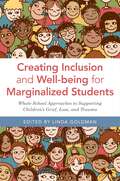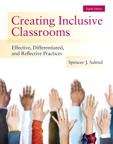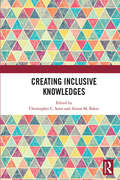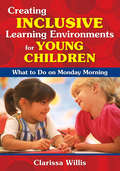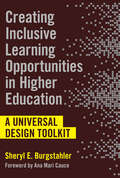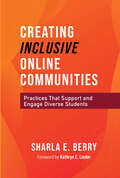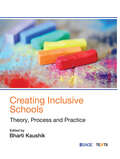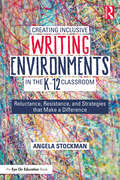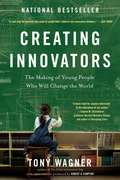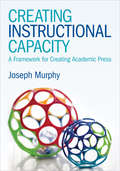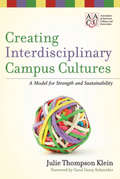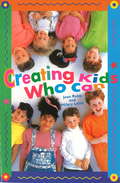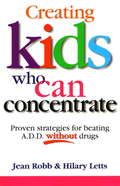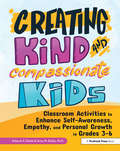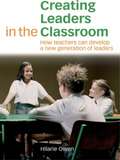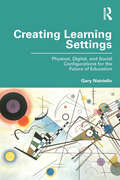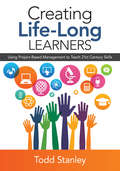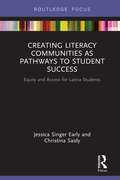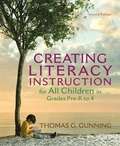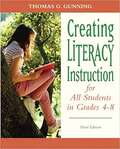- Table View
- List View
Creating Inclusion and Well-being for Marginalized Students
by Linda GoldmanIt is increasingly challenging for teachers to educate without a deeper understanding of the experience of their students. This is particularly the case in marginalised groups of young people who are subject to loss, grief, trauma and shame. Through a snapshot of the diverse student populous, this book explores the impact of these experiences on a student's learning and success. Topics covered include poverty, obesity, incarceration, immigration, death, sexual exploitation, LGBT issues, psychodrama, the expressive arts, resilience, and military students. The authors share the children's perspective, and through case studies they offer solutions and viable objectives.
Creating Inclusive Campus Environments For Cross-cultural Learning And Student Engagement
by Shaun R. Harper Sylvia HurtadoDiversity, multiculturalism, and inclusion are values espoused by most colleges and universities; yet many educators, including those in student affairs, expect students to "magically" interact with peers from different cultural backgrounds on their own. With recent calls for accountability in higher education, it is more important than ever for educators to reconsider ways in which they prepare students for participation in a diverse democracy. Creating Inclusive Campus Environments for Cross-Cultural Learning and Student Engagement shows how to capitalize in educationally meaningful ways on the diversity that exists on campuses across the nation. It offers forward-thinking strategies and examples of good practice that will reshape the way readers think about approaching the work of multicultural education. Written by seasoned researchers and emerging scholars in diversity issues and student affairs practice, this provocative book offers practical solutions, innovative models, and pedagogical guides for creating inclusive environments that facilitate learning via cross-cultural engagement. In addition, first-person narrative accounts from undergraduate students provide illuminating insight not often found in other works on diversity. Creating Inclusive Campus Environments is the leading resource for higher education professionals seeking to understand and facilitate cross-cultural learning.
Creating Inclusive Classrooms: Effective, Differentiated, and Reflective Practices (Eighth Edition)
by Spencer J. SalendCreating effective inclusive classrooms means understanding the role of education in a democratic society and federal legislation, as well as aligning your instruction with national and state standards. But the practical, up-to-date and digital eighth edition of Creating Inclusive Classrooms: Effective, Differentiated and Reflective Practices recognizes that it means more than that. It means using current research related to effective practices in curriculum, instruction, technology, assessment, classroom management, collaboration, and family involvement to foster the learning of all of your students. It means being an evidence-based and reflective educator who continually collects and analyzes evidence to document and enhance the effectiveness of your professional practices, and who thinks critically about your own values and beliefs so you can better differentiate your instruction and promote the learning of all of your students. It means being sensitive and responsive to diversity and individual differences, and collaborating with your students and their families and other educators to create the most successful educational experience for all of your students.
Creating Inclusive Knowledges
by Christopher C. Sonn Alison M. BakerThere has been a growing interest in the role of arts and cultural practice in tackling perennial forms of social exclusion, marginalization, and oppression. Researchers and educators from different disciplines have been collaborating with community-based agencies and community groups to forge new ways to challenge these forms of exclusion. This volume discusses how various social actors, work in interdisciplinary and cross-institutional ways to push an agenda that privileges those individuals and groups, who experience and live at the front line of social inequality, discrimination, racism and oppression. For instance, what new understandings are generated through creative, interdisciplinary, action oriented work, and the implications for social action and transformation? How are community pedagogies constructed and communicated through arts-based research, contemporary and innovative mediums such as creative performances, arts, technologies, mixed-cultural practices and social media and networking? This collection of articles, blurs the lines between cultural practice and knowledge production, with the process and products coming in the forms of theories, creative methodologies, and a range of arts. Together these act as powerful pedagogical tools for engaging in social justice and transformative work. The contributions further highlight the multifaceted and diverse ways of creating and disseminating knowledge, and the attempts to decenter text-based ways of communicating in hopes of sharing collaborative knowledge beyond the academy and engaging the ‘public’. This volume was originally published as a special issue of the International Journal of Inclusive Education.
Creating Inclusive Learning Environments for Young Children: What to Do on Monday Morning
by Dr Clarissa WillisThis book provides information on common disabilities and practical strategies for creating inclusive environments and building student relationships.
Creating Inclusive Learning Opportunities In Higher Education: A Universal Design Toolkit
by Sheryl E. Burgstahler"In Creating Inclusive Learning Opportunities in Higher Education, Sheryl Burgstahler provides a practical, step-by-step guide for putting the principles of universal design into action"
Creating Inclusive Learning Opportunities in Higher Education: A Universal Design Toolkit
by Sheryl E. BurgstahlerIn Creating Inclusive Learning Opportunities in Higher Education, Sheryl Burgstahler provides a practical, step-by-step guide for putting the principles of universal design into action. The book offers multiple ways to access, engage with, and transform the higher education environment: making physical spaces welcoming to students of all abilities; creating digital learning and assistive technology programs that meet the needs of all users; developing universal design in higher education (UDHE) syllabi, assessments and teaching practices that minimize the need for academic accommodations; and institutionalizing universal design supports and services. A follow-up to Universal Design in Higher Education, Burgstahler&’s new book will be a valuable resource for leaders, faculty, and administrators who are interested in acquiring the tools needed to create barrier-free learning environments. Filled with applications, examples, recommendations, and above all, a framework in which to conceptualize UDHE, this volume will help educators meet the design needs of all students and honor the principles of diversity and inclusivity.
Creating Inclusive Online Communities: Practices that Support and Engage Diverse Students
by Sharla BerryBefore the Covid-19 pandemic, online and distance education enrolled over 19 million students in the US. As colleges and universities return to in-person instruction, the number of online courses and programs is poised to grow exponentially. At the same time, institutions of higher education are increasingly more diverse--racially, ethnically, and socioeconomically--with present and future students having a range of intersectional needs related to their cultural backgrounds, gendered experiences, and abilities. Sharla Berry offers faculty practical strategies for building asynchronous, synchronous, and blended online courses and programs that are inclusive and engaging for diverse learners. Recognizing that community is a complex, contextual and constantly shifting concept, Sharla Berry opens this book by addressing how to develop an inclusive approach to online teaching that takes into account the experiences and needs of historically marginalized and underrepresented students. Covering the affordances and limitations of synchronous and asynchronous teaching, as well as hybrid and fully online instruction, she outlines different approaches to course design, and identifies how to use the myriad functions of learning management systems—from collaborative tools to administering tests—to engage students and assess their involvement and progress.While primarily designed to provide faculty with practical and actionable ideas and strategies, this book will also prove useful to those that support faculty in cultivating teaching excellence. Administrators, instructional designers, faculty developers and support staff will gain insight into how to support faculty in developing robust and inclusive online courses.This book is a thoughtful and practical resource for anyone involved in the teaching and design of online courses and programs that meet the needs of an increasingly diverse student body in an evolving and multifaceted online environment.
Creating Inclusive Schools: Theory, Process and Practice
by Bharti KaushikCreating Inclusive Schools aims to simplify the dynamic and multidimensional discipline of Inclusive education for the students of education, and trainee and practising teachers. This book focuses on understanding the learning needs of children with disabilities and those from the socially and economically disadvantaged sections of society. It elucidates and critically analyses how these requirements are currently addressed at various levels of education and the desirable changes that can be brought about. The book explains multifarious concepts in lucid language, and establishes crucial links between theory and practice to facilitate understanding of the different dimensions of inclusive education. This textbook offers a fresh perspective into inclusive education needs, policies and practices through contextually relevant examples and cases. It is based on the curriculum guidelines prescribed by National Council for Teacher Education (NCTE) and the syllabi recommendations by major universities across India. Key Features: Provides holistic understanding of inclusion in education with focus on various aspects of school environment and administration. Contains succinct discussion of the learning needs and strategies to address them in an inclusive education setting. Each chapter aided by learning objectives and chapter-end exercise to help readers map their progress and achievements.
Creating Inclusive Writing Environments in the K-12 Classroom: Reluctance, Resistance, and Strategies that Make a Difference
by Angela StockmanTimely and accessible, this book offers tangible strategies that will help teachers plan and sustain writing workshop experiences that are responsive to the needs of their specific students. Angela Stockman helps teachers understand why some writers may fail to meet their expectations and how to help all writers reach their fullest potential. Organized in three parts, this book reframes common narratives about resistant writers, empowers teachers to design, lead and refine their workshop, and provides a toolkit to do so. The appendices and eResources included provide teachers with instructions for mini-lessons and learning targets that support multimodal composition, perfect for pre-service and in-service teachers.
Creating Innovators
by Tony Wagner<P>From a prominent educator, author, and founder of Harvard's Change Leadership Group comes a provocative look at why innovation is today's most essential real-world skill and what young people need from parents, teachers, and employers to become the innovators of America's future. <P>In this groundbreaking book, education expert Tony Wagner provides a powerful rationale for developing an innovation-driven economy. He explores what parents, teachers, and employers must do to develop the capacities of young people to become innovators. In profiling compelling young American innovators such as Kirk Phelps, product manager for Apple's first iPhone, and Jodie Wu, who founded a company that builds bicycle-powered maize shellers in Tanzania, Wagner reveals how the adults in their lives nurtured their creativity and sparked their imaginations, while teaching them to learn from failures and persevere. <P>Wagner identifies a pattern--a childhood of creative play leads to deep-seated interests, which in adolescence and adulthood blossom into a deeper purpose for career and life goals. Play, passion, and purpose: These are the forces that drive young innovators. <P>Wagner shows how we can apply this knowledge as educators and what parents can do to compensate for poor schooling. He takes readers into the most forward-thinking schools, colleges, and workplaces in the country, where teachers and employers are developing cultures of innovation based on collaboration, interdisciplinary problem-solving, and intrinsic motivation. The result is a timely, provocative, and inspiring manifesto that will change how we look at our schools and workplaces, and provide us with a road map for creating the change makers of tomorrow.
Creating Innovators
by Tony WagnerFrom a prominent educator, author, and founder of Harvard's Change Leadership Group comes a provocative look at why innovation is today's most essential real-world skill and what young people need from parents, teachers, and employers to become the innovators of America's future.In this groundbreaking book, education expert Tony Wagner provides a powerful rationale for developing an innovation-driven economy. He explores what parents, teachers, and employers must do to develop the capacities of young people to become innovators. In profiling compelling young American innovators such as Kirk Phelps, product manager for Apple's first iPhone, and Jodie Wu, who founded a company that builds bicycle-powered maize shellers in Tanzania, Wagner reveals how the adults in their lives nurtured their creativity and sparked their imaginations, while teaching them to learn from failures and persevere. Wagner identifies a pattern--a childhood of creative play leads to deep-seated interests, which in adolescence and adulthood blossom into a deeper purpose for career and life goals. Play, passion, and purpose: These are the forces that drive young innovators. Wagner shows how we can apply this knowledge as educators and what parents can do to compensate for poor schooling. He takes readers into the most forward-thinking schools, colleges, and workplaces in the country, where teachers and employers are developing cultures of innovation based on collaboration, interdisciplinary problem-solving, and intrinsic motivation. The result is a timely, provocative, and inspiring manifesto that will change how we look at our schools and workplaces, and provide us with a road map for creating the change makers of tomorrow. Creating Innovators will feature its own innovative elements: more than sixty original videos that expand on key ideas in the book through interviews with young innovators, teachers, writers, CEOs, and entrepreneurs, including Thomas Friedman, Dean Kamen, and Annmarie Neal. Produced by filmmaker Robert A. Compton, the videos are accessible via links and QR codes placed throughout the eBook text or by visiting www.creatinginnovators.com.
Creating Instructional Capacity: A Framework for Creating Academic Press
by Joseph F. MurphyGreat leaders create stronger foundations by building Instructional Capacity Technology and the age of information have forced educators to rethink how they can create a supportive culture and build academic press. School leaders who learn how to balance these ideas will build successful teams to meet today’s standards. In this companion to Creating Productive Cultures in Schools, Joe Murphy unpacks essential elements of building instructional capacity-Academic Press- through effective management of instruction, curriculum, and assessment. Leaders and change facilitators who read this will: Be reminded how effective instruction works and what forces shape it Understand how powerful assessment ideas can guide successful change Discover secrets to hiring and developing capacity-rich talent Know how to approach and manage curriculum for 21st century outcomes "Over the past decade increasing emphasis has been given by scholars, policymakers and practitioners to the role leaders play in building the capacity of schools to improve teaching and learning. This volume provides a sound foundation for thinking about the meaning of ′capacity′ as well as the tools leaders can use for productive impact." Dr. Philip Hallinger Professor of Educational Management, Chulalongkorn University (Thailand) "This book is a practical synthesis of what we know about fostering instructional improvement that should be a required read for every principal. Murphy goes to the heart of leadership by focusing on what can be done in any school or community to strengthen teachers’ capacity to serve all students. There are no simple checklists, but a wise distillation of core ideas that will work in complex settings." Karen Seashore Louis, Regents Professor University of Minnesota
Creating Instructional Capacity: A Framework for Creating Academic Press
by Joseph F. MurphyGreat leaders create stronger foundations by building Instructional Capacity Technology and the age of information have forced educators to rethink how they can create a supportive culture and build academic press. School leaders who learn how to balance these ideas will build successful teams to meet today’s standards. In this companion to Creating Productive Cultures in Schools, Joe Murphy unpacks essential elements of building instructional capacity-Academic Press- through effective management of instruction, curriculum, and assessment. Leaders and change facilitators who read this will: Be reminded how effective instruction works and what forces shape it Understand how powerful assessment ideas can guide successful change Discover secrets to hiring and developing capacity-rich talent Know how to approach and manage curriculum for 21st century outcomes "Over the past decade increasing emphasis has been given by scholars, policymakers and practitioners to the role leaders play in building the capacity of schools to improve teaching and learning. This volume provides a sound foundation for thinking about the meaning of ′capacity′ as well as the tools leaders can use for productive impact." Dr. Philip Hallinger Professor of Educational Management, Chulalongkorn University (Thailand) "This book is a practical synthesis of what we know about fostering instructional improvement that should be a required read for every principal. Murphy goes to the heart of leadership by focusing on what can be done in any school or community to strengthen teachers’ capacity to serve all students. There are no simple checklists, but a wise distillation of core ideas that will work in complex settings." Karen Seashore Louis, Regents Professor University of Minnesota
Creating Interdisciplinary Campus Cultures
by Schneider Klein Julie Thompson Carol GearyWith the increased support from funding agencies and in literature, an interdisciplinary culture is of growing significance. Creating Interdisciplinary Campus Cultures provides an introduction to interdisciplinary change through pragmatic strategies. Sponsored by the Association of American Colleges and Universities, this unique resource is the only book focused on creating and sustaining institutional support for interdisciplinary work. Since an interdisciplinary culture is of increasingly importance in higher education, this book gives administrators and faculty the tools they need to ensure their work is successful and sustainable.
Creating Kids Who Can
by Jean Robb Hilary LettsA practical and realistic guide for parents and teachers that focuses on a holistic and nurturing approach to learning.Creating Kids Who Can is for parents and teachers of children from preschoolers to teenagers. Jean Robb has devised a learning process that works with all children ? from those with learning difficulties to gifted children. Now Jean and her colleague Hilary Letts have written a book that focuses on an approach to learning that unlocks a child?s ability and creates a child who can learn to read and write, do maths, solve problems. There?s no magic formula or special tricks. No secrets or shortcuts. Just an approach to teaching that breaks down the barriers, does away with labels and unlocks potential.JEAN ROBB and HILARY LETTS are teachers and therapists as well as the founders of Successful Learning, a British education centre dedicated to helping children to fulfil their potential. They are also the authors of CREATING KIDS WHO CAN CONCENTRATE.
Creating Kids Who Can Concentrate: Proven Strategies for Beating A.D.D. Without Drugs
by Jean Robb Hilary LettsThis book is about success and transformation. It shows how, with patience and energy, parents and teachers can turn a child who is noisy, clumsy and forgetful into a child who is calm, careful and attentive.Creating Kids Who Can Concentrate is a practical and realistic book that shows how parents and professionals can naturally and effectively develop a child's potential to become responsible and thoughtful in a remarkably short time. The authors provide expert guidance on:* proven techiques and strategies for overcoming barriers to learning* developing every child's innate skills* how a child is labelled as having A.D.D.* dealing with disruptive or bizarre behaviour, tantrums and children who won't listen JEAN ROBB and HILARY LETTS are teachers and therapists as well as the founders of Successful Learning, a British education centre dedicated to helping children to fulfil their potential. Their first book is CREATING KIDS WHO CAN.
Creating Kind and Compassionate Kids: Classroom Activities to Enhance Self-Awareness, Empathy, and Personal Growth in Grades 3-6
by James Delisle Deborah S. DelisleCreating Kind and Compassionate Kids offers lessons and activities that promote problem solving and social-emotional learning, allowing students in grades 3-6 to become more aware of themselves and others who share their world. Each lesson:Addresses both cognitive and affective skills, enhancing students' appreciation of themselves and others.Encourages students to think creatively and critically.Teaches vital affective skills, such as empathy, tolerance, compassion, communication, and leadership.Includes one or more samples of student work to guide students' responses.Has been tested by teachers in multiple classrooms with students of all ability levels.With its focus on relevant, lasting learning experiences that encourage social and emotional growth, Creating Kind and Compassionate Kids is a resource that teachers will turn to again and again.Grades 3-6
Creating Leaders in the Classroom: How Teachers Can Develop a New Generation of Leaders
by Hilarie OwenThis book encourages the commitment of teachers and parents, in order to develop responsible, self reliant and knowledgeable young people with great leadership skills. Although the books main focus is on the development of the child and their leadership skills, it also has a subtle approach to the development of the teacher and parent. The book aims to: examine the principles of leadership from the teachers perspective look in to what leadership means to children and how they can be educated to be better leaders explore and strengthen existing good practice in schools, developing what teachers do in the classroom and its impact on leadership. In this book Hilarie Owen shares her extensive knowledge and experience with teachers and parents alike, enabling them to develop leadership talent and pass these skills on to children of all ages.
Creating Learning Settings: Physical, Digital, and Social Configurations for the Future of Education
by Gary NatrielloCreating Learning Settings examines the design and implementation of learning settings informed by the newest, most expansive insights into how people learn in the post-industrial age. Educators today are tasked with moving beyond the fixed, traditional practices that have long dominated formal schooling and becoming more dynamic and strategic in arranging learners, facilitators, resources, on-site and virtual environments, and learning experiences. Integrating contemporary theoretical approaches and empirical studies, this book offers a systematic approach to creating settings that leverage the physical, digital, resource, and social dimensions necessary to support learning.
Creating Life-Long Learners: Using Project-Based Management to Teach 21st Century Skills
by Todd M. StanleyWanted for the global workforce: thinkers (and those who can teach them) Where K-12 instruction once centered on content and memorization, today’s educators want, most of all, to teach their students to think critically and perceptively. What better way than with project-based learning (PBL)? Author Todd Stanley provides a teacher-friendly, step-by-step approach to implementing PBL, focusing on the 21st century "three R’s": readiness, responsibility, and relevance. Educators will be prepared to put this practical methodology to work right away, as they learn how to Use project and classroom management skills to create a positive, productive learning environment Develop curriculum around ten different project types Link projects with today’s standards Teach students how to effectively collaborate and bring out the best in each other Readers will find an abundance of ideas and clear guidance, along with new strategies for instilling the skills students need for tomorrow’s workforce. "If you are looking for a way to produce higher level thinkers, you really need to read this book. It is a recipe for successful life long learners." Tamara Daugherty, Teacher Lakeville Elementary School "Student lead project based learning fuses today’s classroom with the demands of the fast paced future. Students need to be able to interact and problem solve not just with each other, but also within the community and with technology. This book is a guide for helping educators make that jump with their instruction." Debra K. Las, Teacher Rochest Public Schools
Creating Life-Long Learners: Using Project-Based Management to Teach 21st Century Skills
by Todd M. StanleyWanted for the global workforce: thinkers (and those who can teach them) Where K-12 instruction once centered on content and memorization, today’s educators want, most of all, to teach their students to think critically and perceptively. What better way than with project-based learning (PBL)? Author Todd Stanley provides a teacher-friendly, step-by-step approach to implementing PBL, focusing on the 21st century "three R’s": readiness, responsibility, and relevance. Educators will be prepared to put this practical methodology to work right away, as they learn how to Use project and classroom management skills to create a positive, productive learning environment Develop curriculum around ten different project types Link projects with today’s standards Teach students how to effectively collaborate and bring out the best in each other Readers will find an abundance of ideas and clear guidance, along with new strategies for instilling the skills students need for tomorrow’s workforce. "If you are looking for a way to produce higher level thinkers, you really need to read this book. It is a recipe for successful life long learners." Tamara Daugherty, Teacher Lakeville Elementary School "Student lead project based learning fuses today’s classroom with the demands of the fast paced future. Students need to be able to interact and problem solve not just with each other, but also within the community and with technology. This book is a guide for helping educators make that jump with their instruction." Debra K. Las, Teacher Rochest Public Schools
Creating Literacy Communities as Pathways to Student Success: Equity and Access for Latina Students in STEM
by Jessica Singer Early Christina SaidyCreating Literacy Communities as Pathways to Student Success offers a model for using literacy as a pathway for secondary students to explore fields from which they are often systematically excluded. In particular, this volume demonstrates how access for young Latina students to STEM related fields can be bolstered through engagement with mentors in writing and reading programs. Written for pre- and in-service teachers, as well as scholars across disciplines, this book aims to re-conceptualize the ways in which writing can best serve ethnically and linguistically diverse students, especially girls.
Creating Literacy Instruction For All Children In Grades Pre-K to 4
by Thomas G. GunningIn response to today's need to tailor instruction for the lower grades (PreK-4), this comprehensive, practical guide gives aspiring and practicing professionals the methods and techniques they need to become highly effective teachers who are well equipped to help all students become proficient readers and writers. Creating Literacy Instruction for All Children in Grades Pre-K to 4 features lesson plans for virtually every major literacy skill or strategy, abundant lists of recommended children's reading, helpful student strategies, numerous reinforcement activities, and real-life illustrations of exemplary teaching, all designed to help teachers incorporate today's most effective teaching methods and techniques into their literacy teaching.
Creating Literacy Instruction For All Students In Grades 4 To 8
by Thomas G. GunningCreating Literacy Instruction for All Students in Grades 4 to 8 gives teachers the best available teaching strategies and sample step-by-step lesson plans for constructing lively, effective reading and writing instruction for all students. With his focus on teaching successfully in today’s diverse classrooms, renowned author Thomas Gunning gives teachers a head start in ensuring quality literacy instruction for all children.
